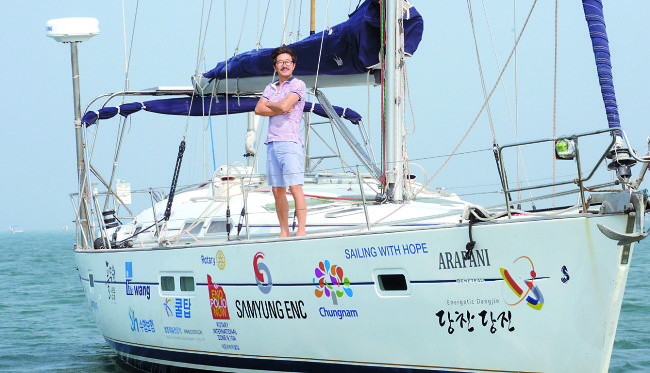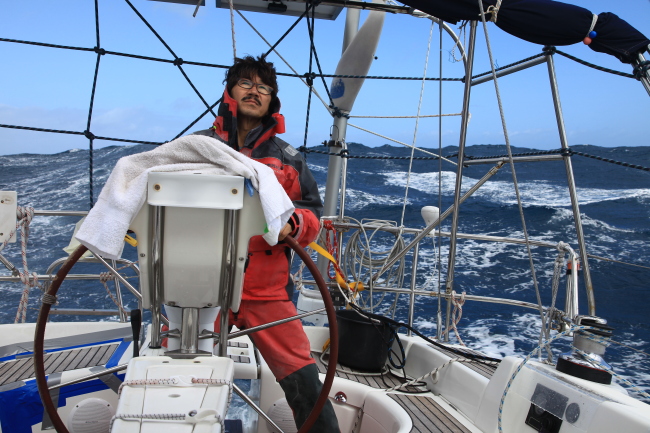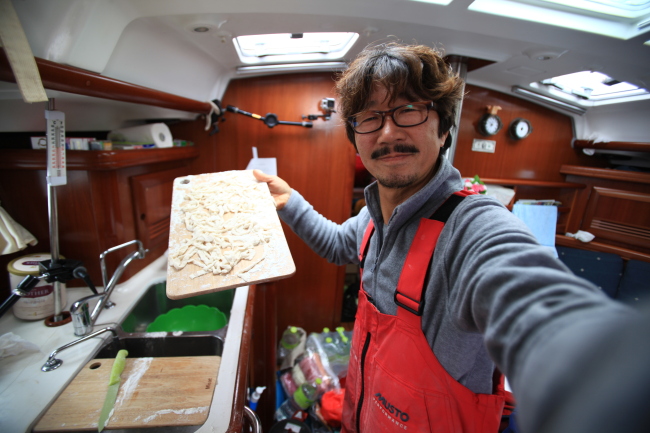The unstoppable dreamer
Documentary producer-turned adventurer sails around the world solo, non-stop
By Korea HeraldPublished : June 19, 2015 - 20:23
DANGJIN, South Chungcheong Province ― Sailing solo, nonstop, unassisted by motor power for 41,900 kilometers to circumnavigate the globe: That is the feat achieved by Kim Seung-jin.
Returning to Waemokhang Harbor in South Chungcheong Province on May 16 after 209 days on the high seas, Kim became the sixth person in the world and the first Korean ever to have successfully completed the challenge.
I met up with Kim, 53, at his trailer base camp at Waemokhang Harbor, a small village known for its beautiful sunrise, where his sailboat the Arapani is anchored about 500-600 meters from the shore.
Returning to Waemokhang Harbor in South Chungcheong Province on May 16 after 209 days on the high seas, Kim became the sixth person in the world and the first Korean ever to have successfully completed the challenge.
I met up with Kim, 53, at his trailer base camp at Waemokhang Harbor, a small village known for its beautiful sunrise, where his sailboat the Arapani is anchored about 500-600 meters from the shore.

“I am probably the only one to have set off in a non-marina setting,” Kim says as he offers a handshake. I am struck by the firmness of the grasp and then notice the calloused and leathery hand of the man who has weathered Antarctic storms and the blinding sun of the Equator.
Sailing on the southern trade winds, Kim traveled eastward, traversing the Pacific Ocean, the Antarctic Ocean, the Atlantic Ocean and the Indian Ocean, covering a total distance of 22,600 nautical miles. Kim became Korea’s first “Cape Horner,” a title given to those who travel around the treacherous Cape Horn, often called the Everest of the Seas, on Feb. 2.
A former documentary producer who specialized in adventures and wilderness, Kim seems to thrive in the dangers that they present. A book by a Japanese man who had accomplished unassisted solo sailing around the world in 1998 at age 24 caught Kim’s eye during a business trip to Japan in 2001. His curiosity piqued, Kim read voraciously about yachting and began plotting his own journey.
“I discovered a new world,” Kim says.
In 2010, Kim took a step closer to realizing his dream when he bought the Arapani in Croatia and sailed backed to Korea. The 12-passenger yacht, which cost 300 million won, was paid for by selling his apartment.
Didn’t his family object? “No one objected or said no to my adventures,” he says, although he is now estranged from his wife.
When the time came for his ultimate solo journey, Kim sold everything ― from his car to his watch ― to fund the project. Heaven helps those who help themselves, and Kim found a staunch supporter in the city of Dangjin, who provided funding and support, hoping that the journey would attract tourists. When the word spread about Kim’s adventure, some 700 individual sponsors pitched in, as did the South Chungcheong Provincial Government, the Ministry of Oceans and Fisheries and small businesses who helped out in cash and kind. The Arapani, which means sea snail in Korean, set sail on Oct. 19, 2014, bearing on her sides the names of the sponsors who asked that their dreams, too, be carried with her.

A typical day would see Kim rise with the sun at 5 a.m. or 6 a.m. He started the day with coffee in the cabin ― either an Americano or a latte made with infant formula ― depending on when he would have to have breakfast. “I ate two meals a day and sometimes I needed to delay breakfast by having a filling latte,” Kim explains. “Then I would go out and feel the outside world. I would then inspect the yacht and make repairs as necessary.”
Life in the high seas sounds rather humdrum by Kim’s account. He spent most of the time in the cabin ― the deck was either too cold or too hot ― thinking about what to eat. “The biggest joy is eating,” he says with a big laugh. “There are limited ingredients and I ate rice and soup 70 percent of the time,” Kim says.
For lunch, Kim would have some snacks, and for dinner about an hour before sundown, usually the leftovers from the breakfast he ate. “This saved electricity and it is safer to finish everything when there is light,” he explains. He set off with three solar panels and a wind generator aboard, but the wind generator broke in a storm. After showering, he would watch the sunset. “That was the happiest, most beautiful time,” he says.
While sailing near the Equator was enjoyable, passing through the Antarctic Ocean was tough.
“The weather was bad 70 percent of the time,” he says. In fact, favorable winds prevailed less than 10 percent of the time throughout the journey, but he had to make all conditions favorable. Just as the storms were bad, forcing him to ride out the big waves in the cabin as the yacht rolled over and righted itself, windless days were “hellish,” too. “When there was even a tiniest bit of wind, I needed to grab onto it,” he says.
Other than the ferocious Antarctic storms and the floating icebergs with their menacing sounds, the most harrowing moment came while sailing through the Sunda Strait, between Java and Sumatra, an area infested with pirates. “All I wanted was to be able to continue the journey even if the yacht were attacked by pirates. So, in preparation, I hid my films, the 10 cameras, and tools,” he says. He turned off all the lights and held his breath in the cabin as the yacht passed the strait unharmed.
At which point did he feel that the journey was worth the tremendous dangers? “When I was turning at the Antarctic Ocean, I thought it was all worth it. The sound of thunder made by the floating icebergs, the seagulls that kept me company, and the communication with nature all made me feel I did well to come here,” he says. The Antarctic was mostly very dark, the sun coming out for maybe three days a month. “There were no stars, no moon, no horizon. Just darkness. Then when the sky opens up, the stars are incredible. It looks like someone has sprinkled flour into the night sky,” he says, gesturing as if sprinkling stars into the air.

How has the epic journey changed him? “Nothing has changed, I think. I keep thinking that humans are miniscule, just an extremely small part of nature and that we should be humble. I think I should treat people around me a little better,” he says.
Since his return, Kim has been in great demand as a celebrity speaker. He tells children to have curiosity, which will lead them to their dream. For the young people, Kim’s message is: “When you discover something you like, don’t forget it. When the opportunity arises, seize it. You can realize your dream.”
“It doesn’t take a special person to realize his dream. It is not a distant rainbow. We give up prematurely,” he says. “Don’t blame others when it is you who does not have the courage.”
Kim’s next adventure involves organizing a team of two or three yachts to sail around the world, calling on well-known ports. “This would mark the 500th anniversary of Magellan’s circumnavigation in 2019,” Kim says, adding with a laugh, “It could be called the ‘Kimgellan.’”
By Kim hoo-ran (khooran@heraldcorp.com)
-
Articles by Korea Herald


![[Exclusive] Korean military set to ban iPhones over 'security' concerns](http://res.heraldm.com/phpwas/restmb_idxmake.php?idx=644&simg=/content/image/2024/04/23/20240423050599_0.jpg&u=20240423183955)

![[Graphic News] 77% of young Koreans still financially dependent](http://res.heraldm.com/phpwas/restmb_idxmake.php?idx=644&simg=/content/image/2024/04/22/20240422050762_0.gif&u=)



![[Pressure points] Leggings in public: Fashion statement or social faux pas?](http://res.heraldm.com/phpwas/restmb_idxmake.php?idx=644&simg=/content/image/2024/04/23/20240423050669_0.jpg&u=)










